Leaving Negative Thoughts Behind when You Head to the Tee Box
How does worrying impact our golf performance? What strategies can we use to manage it?
ARIZONA IS KNOWN for many things. Tourists flock from all over to escape the winter and enjoy some of our world-class resorts, amazing restaurants, the Grand Canyon and all it offers and–of course–over 300 golf courses throughout the state.
One thing that you might not immediately think of is baseball. Every February, Phoenix/ Scottsdale and the surrounding areas host Spring Training baseball for 15 teams–half of Major League Baseball. If you’ve never been to a Cactus League game here in Arizona, you don’t know what you’re missing.
Did you know that golf and baseball have a lot in common? One of the biggest misconceptions I often hear from golfers is that they have too much of a baseball swing and that it causes them to hit poor shots. In fact, that couldn’t be farther from the truth. There are a lot of similarities between the golf swing and swinging a baseball bat.
The athletic motion of the body moving through the ball with the club/bat as it swings around the body follows a certain movement pattern that is referred to as “Kinematic Sequence.” Simply put, when our body is required to make an athletic movement, four different body parts move–but at different times, ranges and speeds. Your hands move first—and fastest—in your golf swing. They are also the one body part that moves the greatest distance around your body.
If the hands are the first thing to move the club, the arms come second. Both arms move before the torso rotates and the hips turn to round off the backswing. It is your job at the top of the backswing to start your downswing in the reverse order: hips turn, torso rotates, arms return back towards the golf ball before you release the club with the hands. Maintaining this sequence will ensure that the club stays on plane and its path through impact travels towards the target.
So, how can baseball help you play golf? It can certainly stop you slicing your shots. A slice is caused when you come over the top and your swing path is outside-in on the down- swing–a problem resulting from a violation of your downswing kinematic sequence. Basically, you’re having a false start at the top of your backswing because the arms and hands are moving towards the ball before the hips and torso. To create the correct sensation with your downswing sequence, something simple as making baseball swings with a golf club or even a bat can certainly help.

As you complete your backswing, your torso has fully rotated to where your lead shoulder is underneath your chin. At the same time, your hips have turned so that your weight is loaded to- wards the instep of your back foot. Completing your backswing is extremely important if you want maximize your distance and unleash all your power on your downswing.
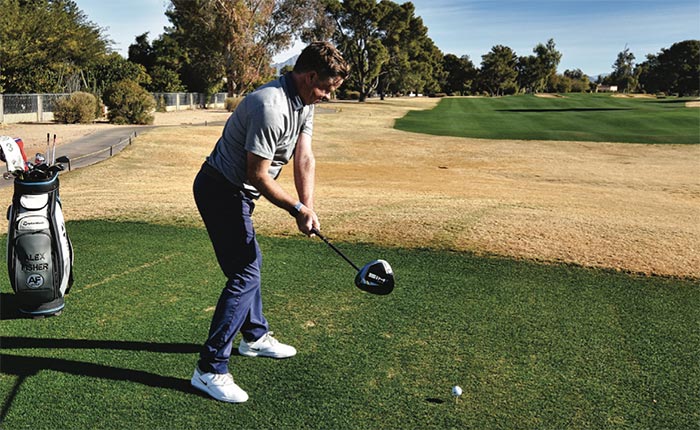
Slicing the ball comes from being in too much of a rush to get back to the ball. If you allow your arms and hands to move before the hips and torso, the club will be above the swing plane and travel through impact on an outside-to-in path. At the same time, the forearms and hands will under-rotate, causing the clubface to be open through impact. All power has been lost!
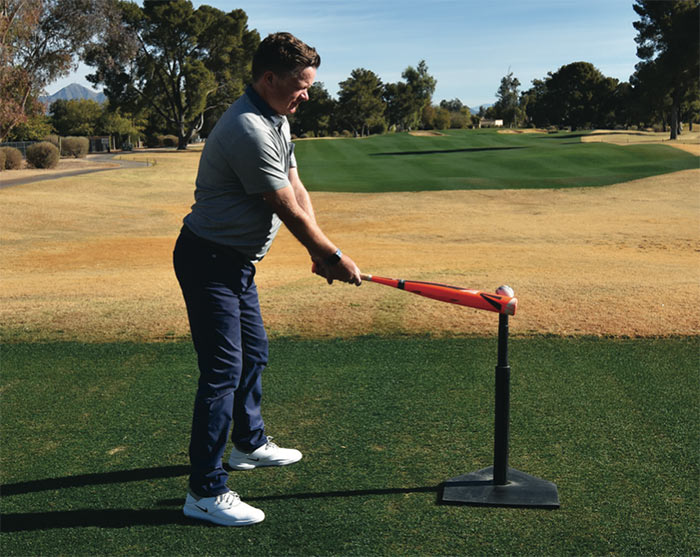
Just like in golf, the baseball bat has to be swung on the correct swing plane in order for the batter to hit the ball. The sequence of body movement is exactly the same as the golf swing. From an upright standing position, point either a baseball bat or a golf club out in front of you at hip height. If you don’t have a hitting tee, instead make a visual note of an object that you can point towards right in front of you.
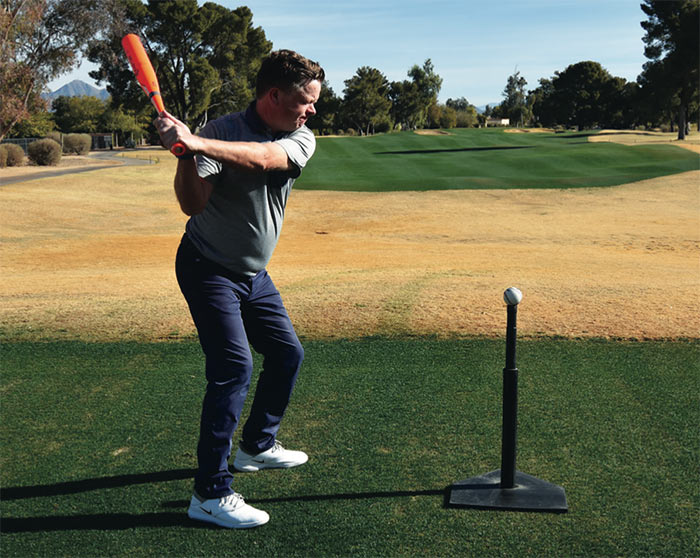
Following the correct kinematic sequence of hands, arms, torso, hips on the backswing, make sure that your body fully rotates while approximately 75% of your weight loads to your back foot. Note how the shoulders have rotated almost twice as much the hips. It’s the disassociation between upper and lower body that creates speed on your downswing.
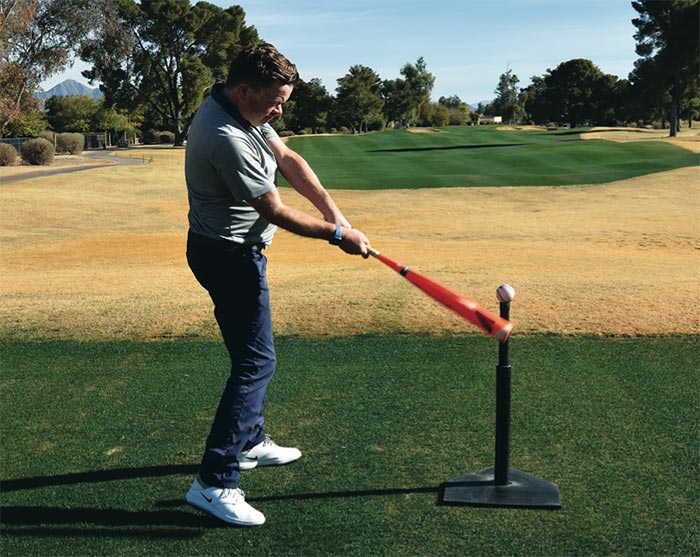
To keep the body’s sequence in order as you return the club back to the golf ball, the very first thing that moves down towards impact is your lower body weight transfer. This doesn’t mean that you have to fire your hips— they just have to go before your upper body starts to move. Keeping your trailing elbow tucked before the forearms and hands rotate through impact will ensure that club stays on the correct plane. At impact, approximately 75 percent of your weight should have transferred to your front foot. If your swing plane through impact isn’t correct, the club/bat will swing under the ball, causing you to miss it.
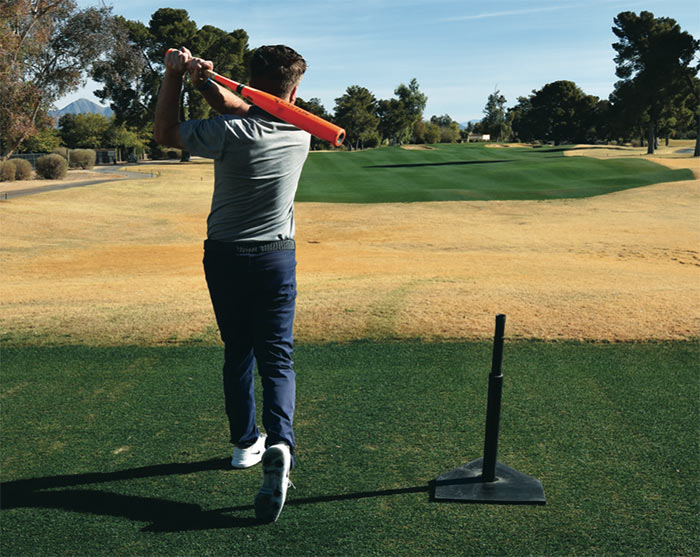
As you finish the swing, your weight should be approximately 90 percent on your front foot while remaining balanced. A good rule of thumb is that your upper body will have fully rotated and be facing your target. You should also be able to tap your back toe to the ground.
Even if you can’t relate to a baseball swing, the same sequence is performed while swinging a tennis racket or even throwing a ball. Each of these are reaction sports, where our body reacts because of our instincts. Because the golf ball is hit from a stationary position and not moving, it’s way more difficult to not violate the sequence as you hit the ball. Get this sequencing down and you’ll be ready to step up to the plate—sorry, tee box—and touch ’em all!
Alex Fisher is PGA Director of Instruction at the JW Marriott Camelback Golf Club in Scottsdale, AZ and The Glacier Club in Durango, CO. Reach him at 602-363-9800.
This article was also featured in the Spring Issue of Colorado AvidGolfer.
Colorado AvidGolfer is the state’s leading resource for golf and the lifestyle that surrounds it, publishing eight issues annually and proudly delivering daily content via coloradoavidgolfer.com.
How does worrying impact our golf performance? What strategies can we use to manage it?
The secret ingredient of Colorado golf course success is well-fed caddies, cooks and groundskeepers
Colorado State grad Davis Bryant opens up on his path to the pros and what keeps him busy when he’s off the course
The staff at Dream Makers Landscape is ready to help you enhance the look and feel of your property with our exceptional landscaping projects